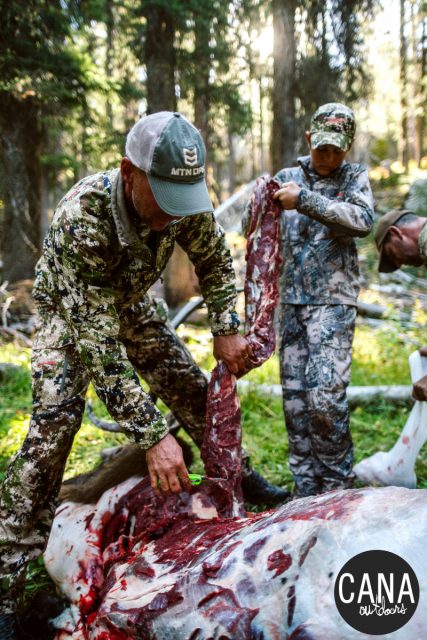Elk Meat Care – Warm Weather Precautions
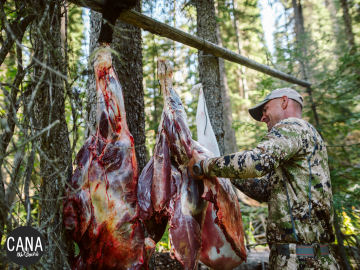
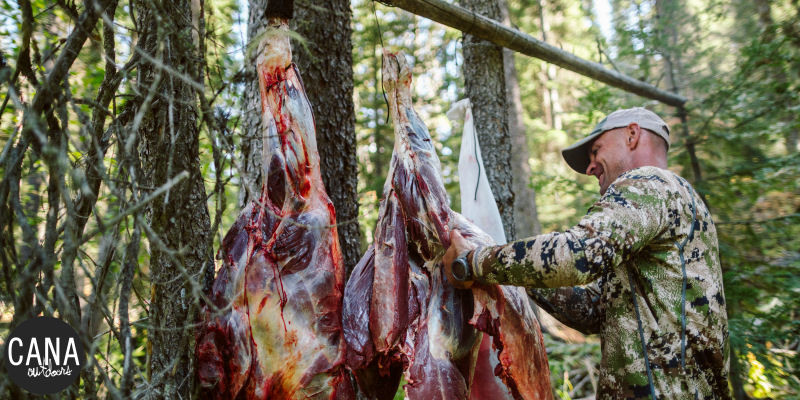
It seems a little odd to be writing an article on warm weather meat care right now. As I type this, the temperature outside is hovering just above 10 degrees. However, it wasn’t too long ago, and it isn’t too far into the future, when temperatures in elk country will be much, much warmer. Many times, our planning takes us only to the point where we reach our intended goal. We spend countless hours preparing to accomplish a difficult task, yet fail to recognize the elements that are often encountered after we reach our goal.
Elk hunters are no different. Our goal is usually centered around some level of success, but our preparations don’t always include what takes place after we put the cameras away. Field processing and the packing of elk meat can sometimes be enough to rain on the otherwise glorious sunset of success, especially if we aren’t prepared. That figurative rain can become a downpour if we are trying to do this in extreme heat. If a long-distance pack out of the backcountry to the nearest cooler is added to these elements, we just hit flash flood stage.
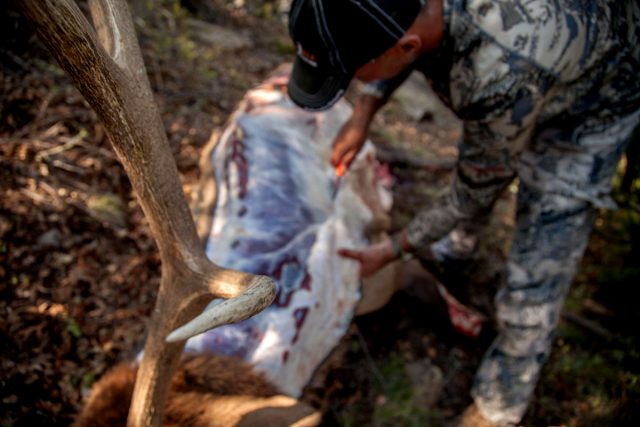 For those who haven’t yet experienced the chore of processing and packing an elk of your own, it is vital to be prepared ahead of time. In September and October, the clock is usually ticking, and a lack of preparation can lead to a needless loss of precious elk meat. For those who have been involved in processing and packing an elk, but haven’t had to worry about doing it under the magnified rays of extreme heat, or over the course of several hours (or days), there are definitely a few things you’ll want to consider as you prepare for your next hunt.
For those who haven’t yet experienced the chore of processing and packing an elk of your own, it is vital to be prepared ahead of time. In September and October, the clock is usually ticking, and a lack of preparation can lead to a needless loss of precious elk meat. For those who have been involved in processing and packing an elk, but haven’t had to worry about doing it under the magnified rays of extreme heat, or over the course of several hours (or days), there are definitely a few things you’ll want to consider as you prepare for your next hunt.
When it comes to taking care of elk meat in the field, especially when you can’t get it to a butcher or a cooler for several days, it takes some forethought and planning. For this discussion, I’m going to assume you know how to get the meat off the elk, and focus instead on how to take care of meat once it has been removed from the carcass. If you need instructions for quartering an elk in the field, check out the Gutless Method video at www.Elk101.com (or sign up for the University of Elk Hunting Online Course for full details of every step of Field Processing).
It isn’t necessarily uncommon for temperatures in September to reach into the 90’s in many elk hunting areas, and it’s possible for nighttime temperatures to stay above 50 degrees. This can provide a precarious situation for hunters to try and store elk meat in. If you are hunting in the backcountry, or you’re planning on hanging the meat in camp while you continue hunting, a little knowledge and preparation will go a long way.
There are three things to keep in mind that are bad for elk meat: heat, moisture, and bugs. Getting the meat cool and keeping it dry and protected from flies is critical for preventing spoilage, bacteria growth, and damage.
Weather, and temperatures, in the fall are always a wild card. We can go from snow and frigid cold back to blazing heat in a matter of hours. Losing valuable elk meat due to negligence or a lack of planning is not an outcome any of us desire, and can be avoided with a little forethought.
If temperatures are getting down below 40 degrees at night, and not getting above the 70’s during the day, you will usually be just fine to hang the quarters from a meat pole at the kill site or back at camp, even for several days. If temperatures are above the mid-70’s during the day, you’re going to need to work harder to cool the meat and then keep it cool throughout the day. Or, find a local butcher that will allow you to hang the meat in their walk-in cooler until your hunt is over.
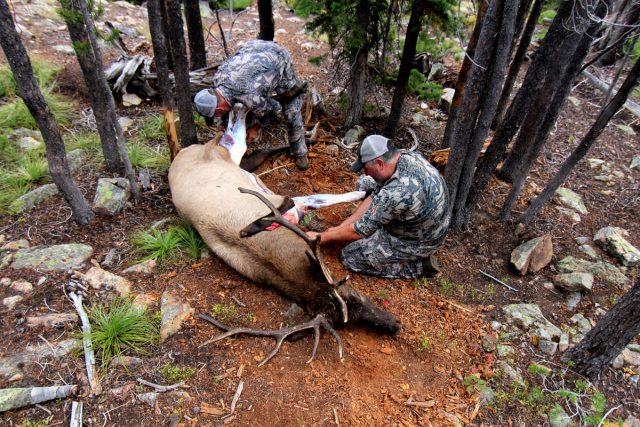 Regardless of how you plan to keep the meat for the next few days, one of the most important things to do is get the meat cooled off quickly and thoroughly as soon as possible. Cooling the meat rapidly as soon as the elk is down will be a critical component of preventing the meat from spoiling over the next several days. Meat that isn’t cooled quickly initially stands a much greater chance of spoiling – even in cooler weather – than meat that is allowed to cool quickly in hotter weather.
Regardless of how you plan to keep the meat for the next few days, one of the most important things to do is get the meat cooled off quickly and thoroughly as soon as possible. Cooling the meat rapidly as soon as the elk is down will be a critical component of preventing the meat from spoiling over the next several days. Meat that isn’t cooled quickly initially stands a much greater chance of spoiling – even in cooler weather – than meat that is allowed to cool quickly in hotter weather.
In order to allow the meat to cool rapidly, it is imperative that you get the hide off the meat as soon as you kill the animal. The hide is an insulator, and if it is left on the meat, it will trap the heat and cause the meat to begin spoiling almost immediately. Getting the hide off the meat will allow the meat to cool much more rapidly, even in relatively hot conditions. Once the meat cools initially, it’s simply a matter of not letting it heat back up by sitting in the sun or direct heat.
Getting the hide off quickly will also prevent your meat from becoming “gamey”, and add to the overall quality of the final product you will be feasting on for the next several months.
With the hide off, heat is able to escape from the meat and begin the cooling process. From there, breaking the animal down and removing the quarters will also help the meat cool. One area of particular concern is the large muscle mass that makes up the hind quarter. If it is really warm out, I would suggest making an incision along the bone on the hind quarters to allow heat to escape from the meat more rapidly. The leg bone in the hind quarter holds a lot of heat, and the large mass of meat that surrounds that bone ends up becoming an insulator for the heat that is trapped inside. If meat ends up spoiling anywhere on an elk, it usually starts there around the leg bone in the hind quarter.
Another thing to keep in mind is the fact that the ground acts as a great insulator. If the elk is lying on its side for an extended period of time, it is possible for the meat on the bottom side of the elk to retain heat and not cool quickly. It will be important in extremely hot situations to work quickly to not allow the elk to lie on its side for too long. Work quickly, but not carelessly.
Also, if it is really warm out and you plan to let the meat hang for an extended period of time (either there at the kill site or back at camp), I would suggest leaving the bone in the quarter. I know, that doesn’t seem to make a lot of sense, but if you debone the quarters and immediately pack the hot meat into game bags before it cools, the meat will be a large mass of heat and will actually slow down the cooling process.
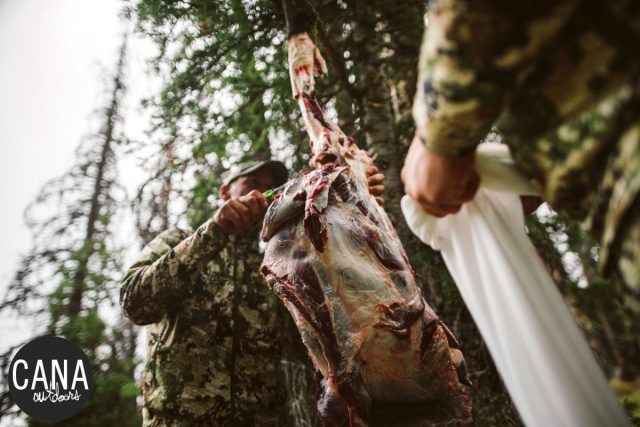 If you leave the meat on the bones, definitely make an incision along the bones to allow heat to escape, but leaving the meat on the bone as it hangs will allow air to circulate around it and actually allow it to cool more rapidly. If you do plan to debone the quarters, allow the individual sections of meat to cool individually before you pack them into a game bag and load them into your pack.
If you leave the meat on the bones, definitely make an incision along the bones to allow heat to escape, but leaving the meat on the bone as it hangs will allow air to circulate around it and actually allow it to cool more rapidly. If you do plan to debone the quarters, allow the individual sections of meat to cool individually before you pack them into a game bag and load them into your pack.
As you remove each quarter off the elk, get it into a quality game bag right away. This will keep the flies and other bugs off the meat while allowing the meat to continue cooling. Then, hang the quarters in a cool, shady spot. I like to construct a makeshift meatpole as soon as we get an elk down, and use it to hang the quarters as we pull them off the elk. Even if I plan to bone-out the quarters, I will put the full quarter into a game bag and hang it in the shade until I have all the meat off the carcass, and then go back and start the process of boning out the quarters. Removing the meat from the bone while the quarters are hanging is much easier, and the meat will have already started cooling down.
If you are packing the meat out and can’t pack it all at once, leave the quarters that you aren’t able to pack hanging there in the shade. Don’t leave them lying on the ground. Keeping the quarters elevated with air circulating around them will allow heat to be drawn out of the meat more quickly. If meat is laid on the ground, the ground will again act as an insulator and keep heat from escaping.
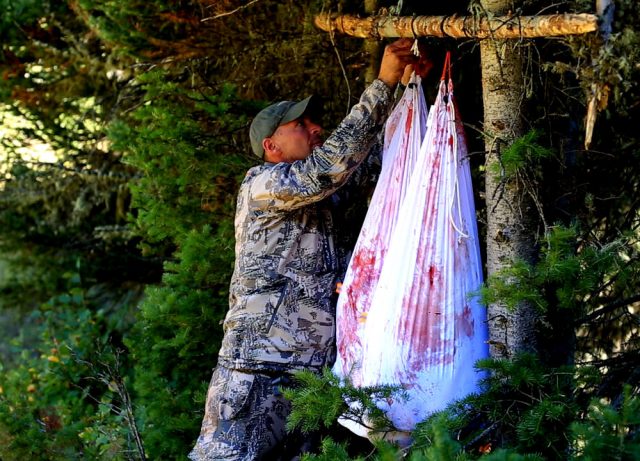 When you get back to camp, you have two options: either hang the meat from a meat pole, or take it in to the nearest town and have it processed or stored at a butcher. Sometimes, local wild-game processors will charge you a minimal fee to hang your meat in their walk-in cooler until you are ready to head home.
When you get back to camp, you have two options: either hang the meat from a meat pole, or take it in to the nearest town and have it processed or stored at a butcher. Sometimes, local wild-game processors will charge you a minimal fee to hang your meat in their walk-in cooler until you are ready to head home.
If this isn’t an option and you are hanging the meat from a meatpole at camp, be sure it is in the shade – not just at 9:00 in the morning, but throughout the day. It will be imperative that you have quality game bags that won’t allow any flies to get inside or lay eggs through the material.
As long as the meat was able to cool down initially, and as long as the nighttime temps get down into the 40’s and don’t get above the mid-70’s during the day, you should be fine to leave the meat hanging there for 3-4 days. Be sure to check it each day and ensure that it isn’t in an area where it will end up in direct sunlight. The meat should be cool to the touch, and as long as it stays in the cool shade, it should be just fine until you get it in to a butcher.
As I mentioned in the beginning, moisture is an enemy to elk meat. Moisture magnifies the rate that bacteria is able to form, and speeds up the process of meat spoilage. To keep meat dry, again, use a quality game bag. Synthetic game bags are helpful, as synthetic material does a great job of wicking away moisture. Any moisture that is on the meat is going to be pulled to the outside of the game bag and evaporate, which will aid in protecting the meat. Additionally, placing a small tarp over the meat while it is hanging will help keep rain from soaking the game bags and provide additional shade.
Again, make sure you are using quality game bags so flies and other bugs aren’t able to access the meat. Make sure all open areas of the game bag are securely tied or tightly cinched. I have seen bees chew through cheap game bags to get to the meat, which will then enable flies to get inside and lay eggs.
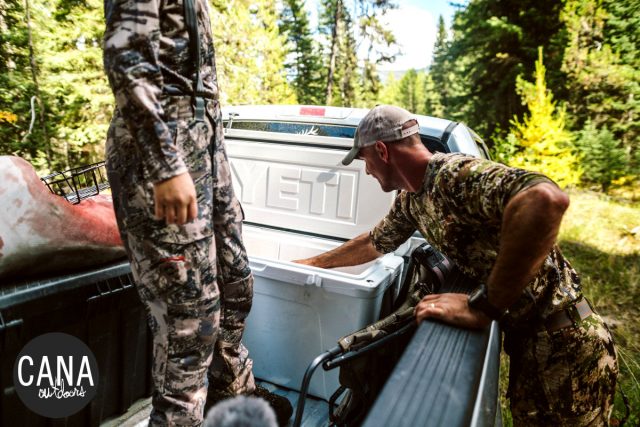 Once you are ready to place the meat in your vehicle and head home or to the butcher, put it in coolers. An elk quarter lying in the back of a truck – even for just a couple of hours – with direct sunlight on it can start to spoil. However, when you put your elk meat into a cooler, keep in mind that moisture is not a good thing and avoid using ice if at all possible.
Once you are ready to place the meat in your vehicle and head home or to the butcher, put it in coolers. An elk quarter lying in the back of a truck – even for just a couple of hours – with direct sunlight on it can start to spoil. However, when you put your elk meat into a cooler, keep in mind that moisture is not a good thing and avoid using ice if at all possible.
If you are travelling a short distance back home and the meat has been hanging at camp and allowed to cool completely, simply placing it in a large cooler will protect it from the outside heat and allow it to stay cool. If you are travelling a long distance though, you’ll need something in the cooler to keep it cool.
I usually stop at the nearest town and purchase dry ice. Many small grocery stores – especially those in elk country – carry dry ice. If you use dry ice, be sure to place it in the bottom of the cooler, and then cover it with a layer of cardboard and/or a thick blanket before you put the meat on it. If the dry ice contacts the meat (even if it’s in a quality game bag), it will “freezer burn” the meat pretty severely. Put a layer of cardboard and/or a thick blanket on the ice, and then lay the meat on top of that.
The dry ice should last for 10-12 hours – depending on how much you buy – and it will keep the meat plenty cool for the road trip. Also, be sure you have coolers that are large enough to hold the quarters. I’ve found that a large cooler will usually hold one front shoulder, a hind quarter, and half the miscellaneous meat. This means I will usually need two large coolers for each elk I plan to transport home.
There is nothing in the world like fresh, organic, well-preserved elk meat. Having a good knowledge of field care and a plan of action for taking care of and preserving the meat in any weather is vital to enjoying the fruits of your labors for the next 11 months.
